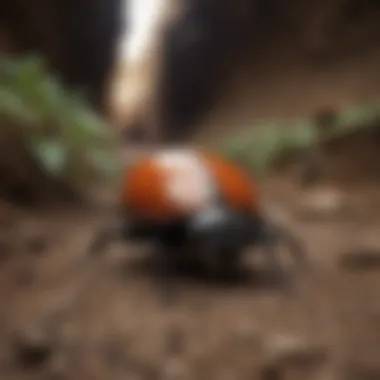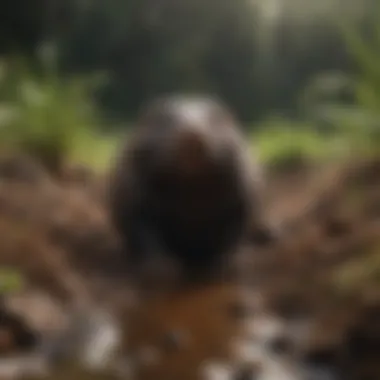Unveiling the Enigmatic World of Soil-Dwelling Insects and Their Mysterious Holes


Nature Topic Overview
Have you ever wondered about the mysterious world of insects that create intricate burrows beneath the earth's surface? These tiny architects, ranging from burrowing beetles to diligent ants, play indispensable roles in shaping and maintaining the delicate balance of ecosystems. Their behaviors and adaptations are nothing short of fascinating, offering a glimpse into the intricate web of life underground.
Fun Facts and Trivia
- Did you know that some burrowing insects create trapdoors to protect their homes from predators?
- Ant lions, with their iconic cone-shaped traps, are skilled predators that lurk at the bottom of conical pits, waiting to ambush unsuspecting prey.
- Visualize the underground world of bugs with interactive diagrams showcasing the anatomy of burrowers and their intricate underground networks.
- Engage young learners with puzzles and quizzes to test their knowledge of these ingenious hole-making insects.
Wildlife Explorations
Step into the realm of underground creatures as we unravel the diverse species associated with hole-making. Discover the evolutionary adaptations of insects like cicadas and dung beetles that rely on burrows for survival. Dive into the unique characteristics of underground plants that coexist with these tunneling insects, forming a complex ecosystem beneath our feet. Engage in interactive activities like scavenger hunts to identify signs of burrowing insects in their natural habitat.
Environmental Awareness
The preservation of these bug-made burrows is crucial for maintaining the biodiversity of ecosystems. Find out how conservation efforts can protect these subterranean habitats and ensure the survival of hole-making insects for future generations. Educate children on simple yet impactful ways to contribute to nature conservation, such as creating bug-friendly gardens and minimizing pesticide use.
DIY Nature Activities
Embark on hands-on adventures with DIY projects inspired by the world of underground bugs. From constructing miniature ant farms to creating clay models of burrowing beetles, children can immerse themselves in the fascinating realm of hole-making insects. Follow step-by-step guides for building bug hotels to provide shelter for ground-dwelling critters in outdoor spaces. Encourage outdoor explorations with nature walks to observe burrowing insects in action and apply newfound knowledge in real-world settings.
Introduction to Underground Architects
The Significance of Burrowing Insects
Impact on Soil Health
Burrowing insects have a profound impact on soil health, influencing the structure and composition of the earth beneath our feet. Their burrowing activities enhance soil aeration, promoting nutrient circulation and fostering a conducive environment for plant growth. Through their intricate tunnels and burrows, these insects play a key role in maintaining a balanced soil ecosystem, crucial for sustaining biodiversity.
Ecological Importance


The ecological importance of burrowing insects extends far beyond the soil itself. These creatures act as ecosystem engineers, influencing the distribution of nutrients, water, and organic matter below the surface. By burrowing and excavating, they create microhabitats for a myriad of organisms, shaping the very foundation of underground ecosystems. Their contribution to nutrient cycling and soil stability highlights their vital role in maintaining ecological balance.
Types of Ground-Dwelling Bugs
Burrowing Beetles
Among the diverse array of ground-dwelling bugs, burrowing beetles stand out for their remarkable tunneling prowess. These beetles use their specialized mandibles to excavate soil and create intricate burrows where they rear their young. The behavior of burrowing beetles significantly influences soil composition and nutrient distribution, showcasing their unique role in underground ecosystems.
Ant Colonies
Ant colonies exemplify the epitome of collaboration and organization in the subterranean world. Through intricate communication networks and division of labor, these insects construct elaborate underground nests that serve as hubs of activity and protection. The systematic nature of ant colonies not only shapes the physical environment but also influences the social dynamics within their communities.
Earthworms
Earthworms, unsung heroes of underground habitats, play a vital role in soil health and fertility. Their constant burrowing and feeding activities facilitate nutrient cycling and improve soil structure, enhancing its ability to retain water and support plant growth. Earthworms' presence in the soil ecosystem signifies a harmonious balance between decomposition and regeneration, making them essential players in the underground landscape.
Adaptations for Underground Life
Specialized Appendages
One of the key adaptations for thriving in underground environments is the development of specialized appendages. These appendages enable insects to navigate through soil particles, excavate burrows, and manipulate their surroundings with precision. From modified legs for digging to sensory organs for orientation, these specialized appendages enhance insects' efficiency in underground tasks, showcasing the evolutionary marvel of underground adaptations.
Communication Strategies
Communication lies at the heart of successful underground communities, where insects employ diverse strategies to convey information and coordinate activities. Through chemical signals, vibrations, and tactile cues, insects effectively communicate within their colonies, ensuring seamless cooperation and division of labor. The intricate web of communication strategies underscores the sophisticated social dynamics prevalent in the underground world, where cooperation is paramount for survival.
Behavioral Patterns and Nesting Habits
In this section of the article, we delve into the crucial aspects of behavioral patterns and nesting habits exhibited by bugs that make holes in the ground. Understanding the behavior of these underground architects is key to appreciating their role in ecosystems. The meticulous excavation and nesting behaviors of these insects contribute significantly to soil structure, nutrient cycling, and overall ecosystem health. By exploring how bugs such as burrowing beetles, ants, and earthworms establish their underground dwellings, readers gain insights into the intricate web of life beneath the surface.


Tunnelling Techniques of Bugs
Spiral Burrowing
Spiral burrowing is a fascinating technique employed by certain ground-dwelling bugs to create intricate tunnels beneath the earth. This method involves a twisting motion as insects navigate through the soil, resulting in spiral-shaped burrows. The key characteristic of spiral burrowing is its efficiency in aerating the soil and promoting proper drainage, which are crucial for the health of underground ecosystems. Despite its advantages in enhancing soil quality, spiral burrowing can sometimes lead to soil compaction, impacting nutrient distribution.
Vertical Tunnels
Vertical tunnels represent another common tunnelling technique utilized by bugs in their underground endeavors. These straight tunnels penetrate the earth vertically, providing bugs with pathways for movement and exploration. The primary benefit of vertical tunnels is their efficacy in connecting different underground chambers, facilitating communication and resource sharing among bug communities. However, the construction of vertical tunnels may disrupt soil structure in certain contexts, influencing water flow and root development.
Community Structures in Underground Habitats
Division of Labor
The division of labor within bug communities underground is a crucial aspect that defines their efficiency and resilience. Insects allocate specific roles to different members based on their strengths and abilities, ensuring that tasks such as excavation, foraging, and nest maintenance are carried out effectively. This specialization enables bug colonies to thrive in diverse environments by maximizing resource utilization and cooperative effort. Nevertheless, an overly rigid division of labor can limit adaptability to changing conditions, posing challenges during environmental shifts.
Nesting Chambers
Nesting chambers serve as essential components of bug habitats underground, providing shelter, protection, and space for rearing offspring. These chambers vary in size and complexity depending on the bug species and community size, with intricate architectures designed to meet specific needs. The key feature of nesting chambers is their role in safeguarding eggs, larvae, and pupae from predators and environmental hazards, contributing to the long-term sustainability of bug populations. Despite their advantages, the construction of nesting chambers requires substantial energy expenditure and resource investment, balancing the benefits of protection with the costs of labor and materials.
Interactions with the Ecosystem
In this article, the discussion on Interactions with the Ecosystem is crucial as it sheds light on how underground bugs contribute to the overall balance of ecosystems. By exploring their roles in nutrient cycling, predator-prey dynamics, and habitat maintenance, we gain a deeper understanding of their significance. Understanding these interactions is vital for comprehending the delicate web of life underground and the intricate connections that sustain ecosystems.
Role in Nutrient Cycling
Aeration of Soil
A key aspect of nutrient cycling is the aeration of soil facilitated by burrowing insects. This process involves the movement of air and water through the soil, which is vital for maintaining soil health and fostering plant growth. The unique characteristic of aeration of soil is its ability to enhance soil structure and promote the distribution of essential nutrients to plant roots. This aerating action not only benefits underground bugs but also has a positive impact on the entire ecosystem by supporting plant vitality and biodiversity.


Decomposition Activities
Another integral part of nutrient cycling is the decomposition activities carried out by bugs in the ground. These activities involve breaking down organic matter into simpler forms, releasing essential nutrients back into the soil. Decomposition helps in nutrient recycling and contributes to the fertility of the soil, ensuring its productivity for various plant species. The distinctive feature of decomposition activities lies in their role in maintaining ecosystem balance by efficiently recycling organic materials and supporting the growth of vegetation.
Predator-Prey Dynamics
Subterranean Predators
The presence of subterranean predators among underground bugs influences the ecosystem by controlling prey populations and balancing the food chain. Subterranean predators exhibit key characteristics such as stealth, speed, and specialized hunting techniques, which make them effective in maintaining ecological harmony. Their unique feature lies in their ability to regulate insect populations, preventing overconsumption of plant species and ensuring the stability of underground ecosystems.
Protection Mechanisms
Protection mechanisms adopted by bugs underground are essential for survival and contribute to the predator-prey dynamics in ecosystems. These mechanisms include camouflage, mimicry, and chemical defenses that help bugs evade predators and harmful environmental conditions. The key characteristic of protection mechanisms is their role in enhancing bug's chances of survival, promoting species diversity, and safeguarding ecological balance. Their unique feature lies in the strategic defenses developed by bugs to adapt to underground habitats and thrive amidst various environmental challenges.
Environmental Impact and Conservation
The core of this article delves into the intricate web of interactions between underground bugs and their ecosystem, emphasizing the critical role of environmental impact and conservation in maintaining the delicate balance of nature. Examining the underground realm reveals the profound impact of these burrowing insects on soil health and overall ecological stability, making them fundamental architects of the subterranean world. Through their activities, such as forming tunnels and nests, these bugs significantly contribute to the nutrient cycling processes essential for ecosystem sustainability. Furthermore, their presence aids in soil aeration and decomposition activities, playing a vital role in shaping the underground environment.
Threats to Underground Bug Populations
Habitat Destruction
The menace of habitat destruction poses a grave threat to underground bug populations, disrupting their natural habitats and livelihood. This ruthless practice involves the destruction of bug habitats through human activities like urbanization, deforestation, and land development. The key characteristic of habitat destruction lies in its irreversible impact on bug populations, leading to a decline in species diversity and abundance. Despite its prevalent use in modern society for infrastructural growth, habitat destruction stands as a formidable foe against the conservation efforts aimed at protecting underground bug populations, underscoring the urgent need for sustainable practices.
Pesticide Exposure
Another significant menace confronting underground bug populations is pesticide exposure, which poses dire consequences for these intricate creatures. Pesticides, designed to target agricultural pests, inadvertently harm beneficial bugs through direct contact or consumption of contaminated food sources. The key characteristic of pesticide exposure is its indiscriminate nature, affecting bug populations irrespective of their ecological importance. While pesticides offer a quick solution to pest control, their detrimental effects on underground bugs highlight the necessity for alternative approaches to pest management that safeguard bug populations and promote environmental conservation.
Sustainable Practices for Bug Preservation
Organic Farming Methods
Organic farming methods emerge as a beacon of hope in the realm of bug preservation, offering a sustainable alternative to conventional agricultural practices. The key characteristic of organic farming lies in its avoidance of synthetic chemicals, promoting natural pest control mechanisms and fostering a harmonious coexistence with underground bugs. Through the cultivation of crops without chemical pesticides or fertilizers, organic farming supports bug populations by providing a safe and conducive environment for their proliferation. Despite facing challenges in scalability and initial costs, organic farming holds promise in preserving underground bug populations and promoting ecosystem health.
Habitat Restoration
Habitat restoration initiatives play a crucial role in mitigating the impacts of habitat destruction and nurturing underground bug populations. The key characteristic of habitat restoration lies in its endeavor to recreate and rehabilitate bug-friendly habitats through reforestation, wetland restoration, and ecological landscaping. By restoring degraded ecosystems to their natural state, these initiatives provide a lifeline for bug populations on the brink of extinction, offering them a chance to thrive once again. While habitat restoration requires long-term commitment and resources, its benefits in preserving underground bug diversity and ecosystem resilience underscore its significance in conservation efforts.







